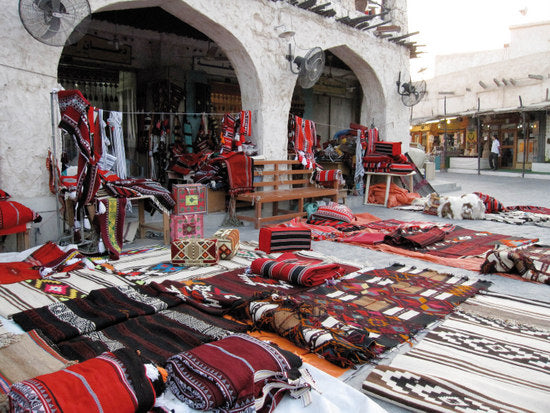
Sadu Weaving: Tradition and Culture
, by Gift byFatma, 3 min reading time

, by Gift byFatma, 3 min reading time
Sadu weaving is a traditional craft that has woven itself into the cultural fabric of the broader Arabian Peninsula. This intricate and beautiful form of textile art has a rich history, spanning centuries, and has evolved into a powerful symbol of Arabian heritage. In this article, we will discuss about the history, evolution, cultural significance, and contemporary relevance of Sadu weaving.
The history of Sadu weaving can be traced back to the Bedouin tribes who have inhabited the Arabian desert for centuries.
Sadu weaving served as an essential part of the Bedouin lifestyle, as it provided not only clothing and shelter but also a way to express their artistic creativity. Historical records indicate that this craft has been practiced in the Arabian Peninsula for over 2,000 years.

( Image Reference: UNESCO )
While Sadu weaving began as a necessity for Bedouin tribes, it has evolved over time to incorporate both traditional and modern elements. The earliest Sadu weavings were primarily made from goat and camel hair, with natural dyes, resulting in earthy tones and muted colors. However, with the arrival of modernization Sadu weavers began to experiment with a broader range of materials and colors, incorporating cotton and synthetic fibers.
Incorporating brighter hues and more complex designs, Sadu weaving began to gain recognition as a distinctive art form in the latter half of the 20th century. The craft found a new purpose in preserving cultural heritage, as well as serving as a source of livelihood for many families.

Souq waqif, Doha
Al-Sadu weaving is an important part of Bedouin culture and heritage. It is a symbol of Bedouin women's skill and creativity. It is also a way for Bedouin people to connect with their past and to preserve their cultural traditions.
Al-Sadu woven textiles are also used in a variety of traditional Bedouin ceremonies and rituals. For example, al-Sadu woven carpets are often used to cover the floors of tents during weddings and other important gatherings. Al-Sadu woven cloaks are also worn by both men and women on special occasions.
In today's fast-paced world, traditional crafts like Sadu weaving face numerous challenges, including competition from modern manufacturing methods and declining interest among the younger generation. To preserve this heritage, many organizations have undertaken initiatives to promote and sustain Sadu weaving.
In 2010, UNESCO recognized Sadu weaving as an Intangible Cultural Heritage, providing global recognition and support for its preservation, artists, have collaborated to bring Sadu weaving into the contemporary art scene, making it relevant to a new generation.
In recent years, there has been a growing interest in al-Sadu weaving among fashion designers and other creatives. Al-Sadu woven textiles have been used to create a variety of contemporary fashion items, such as dresses, skirts, and bags. Al-Sadu woven textiles have also been used to create home décor items, such as cushions, rugs, and wall hangings.
This growing interest in al-Sadu weaving among the creative industries has helped to raise awareness of the craft and to increase the demand for al-Sadu woven textiles. This has helped to support al-Sadu weavers and to ensure the survival of this traditional craft.
Sadu weaving is more than just a craft; it's a living testament to rich history and cultural identity of Arab world. As it evolves to meet the demands of the modern world, Sadu weaving remains a symbol of the country's heritage. Efforts to preserve and promote this art form ensure that future generations will continue to appreciate its beauty and significance, keeping the tradition of Sadu weaving alive for years to come. Whether in its traditional form or as part of contemporary art, Sadu weaving continues to be a shining thread in the culture.